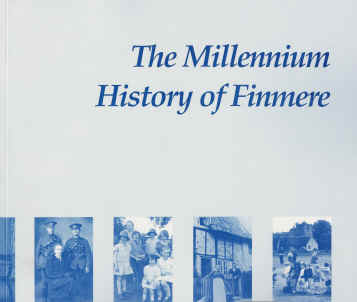
Published 30 June 2001
At 2.45 30 June 2001, Fred Tew, one of Finmere’s oldest residents received the first copy of Finmere’s village history from Ian Hudson, Chairman of Finmere and Little Tingewick Historical Society. Speaking before the launch, 84 year-old Fred said: “I’ll be pleased to get the first copy. The village is full of history and I hear that I appear in the book a few times myself.” When he reads the book, he will find that it records his wartime memories as well as the history of his chicken run. Finmere villagers decided to write a history book in the summer of 1996. Meeting on the lawn of the now abandoned Kings Head pub, like many villages, they decided a book would be a great way to mark the Millennium. But it took longer than they intended and the book is being published 10 months later than planned.
Thirteen people helped write and edit the book. Andy Boddington, the editor and main author says: “Research for the history took me to the intellectual heart of Oxford, the concrete jungle of Aylesbury and, most memorably, the freeways of Los Angeles where I worked in the beautiful setting of the Huntington Library. I am sorry that we are late publishing but we wanted to get it right.” The book was designed by Keith Rogers. “We set out to do something different,” he says. “We used a landscape design and set pictures and text set alongside each other. The idea is that readers can dip in and out of the book, as well as read it from front to back.” Keith used the latest computing and printing technology to keep publication costs down. Thanks to a grant of £975 from the Parish Council and donations of £800 from well-wishers, every household in Finmere and Little Tingewick will receive a free copy of the book.
Having delayed the book launch several times, the launch was nearly cancelled at the last moment. Printing and delivery delays led to the book being delivered only the afternoon before. “I was really anxious,” says Anita Bilbo, who is in charge of the book launch and distribution. “But now we can celebrate after five years of hard work.” The Millennium History of Finmere was launched at Finmere School Fayre. In 26 chapters and 164 pages, it records how the village of Finmere in Oxfordshire and the adjacent hamlet of Little Tingewick in Buckinghamshire have changed over the last two centuries. Readers will find out about an outwardly quiet and inwardly bustling village and of villagers at work, in prayer, revelling at feast and fighting in wars. The book explores how Finmere has maintained its character as it has changed from an overcrowded, poverty-stricken village to a village where most people are wealthier and commute to work elsewhere.
